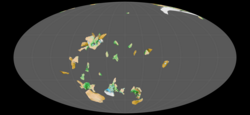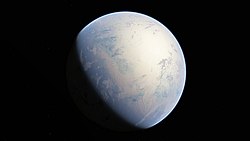
Back Siderium Afrikaans عصر السيدري Arabic Sider dövrü Azerbaijani Сідэрый Byelorussian Siderieg Breton Siderià Catalan Siderium German Período Sidérico Spanish Sideriar Basque سیدرین Persian
You can help expand this article with text translated from the corresponding article in German. (December 2024) Click [show] for important translation instructions.
|
| Siderian | |||||||||||
|---|---|---|---|---|---|---|---|---|---|---|---|
 A reconstruction of the Earth's continents during the middle Siderian, circa 2.4 Ga.[citation needed] | |||||||||||
 A Siderian banded iron formation in Dales Gorge, Western Australia | |||||||||||
 Artist's impression of the Earth during the Huronian glaciation, starting from mid-Siderian | |||||||||||
| Chronology | |||||||||||
| |||||||||||
| Proposed redefinition(s) | 2630–2420 Ma Gradstein et al. | ||||||||||
| Proposed container | Neoarchean Gradstein et al. | ||||||||||
| Etymology | |||||||||||
| Name formality | Formal | ||||||||||
| Usage information | |||||||||||
| Celestial body | Earth | ||||||||||
| Regional usage | Global (ICS) | ||||||||||
| Time scale(s) used | ICS Time Scale | ||||||||||
| Definition | |||||||||||
| Chronological unit | Period | ||||||||||
| Stratigraphic unit | System | ||||||||||
| Time span formality | Formal | ||||||||||
| Lower boundary definition | Defined Chronometrically | ||||||||||
| Lower GSSA ratified | 1991[1] | ||||||||||
| Upper boundary definition | Defined Chronometrically | ||||||||||
| Upper GSSA ratified | 1991[1] | ||||||||||
The Siderian Period ( /saɪˈdɪəri.ən, sɪ-/; Ancient Greek: σίδηρος, romanized: sídēros, meaning "iron") is the first geologic period in the Paleoproterozoic Era and lasted from 2500 Ma to 2300 Ma. Instead of being based on stratigraphy, these dates are defined chronometrically.
The deposition of banded iron formations peaked early in this period. These iron-rich formations were formed as anaerobic cyanobacteria produced waste oxygen that combined with iron, forming magnetite (Fe3O4, an iron oxide). This process removed iron from the Earth's oceans, presumably turning greenish seas clear. Eventually, with no remaining iron in the oceans to serve as an oxygen sink, the process allowed the buildup of an oxygen-rich atmosphere. This second, follow-on event is known as the oxygen catastrophe, which some geologists believe triggered the Huronian glaciation.[2][3]
Since the time period from 2,420 Ma to 2,250 Ma is well-defined by the lower edge of iron-deposition layers, an alternative period named the Oxygenian, based on stratigraphy instead of chronometry, was suggested in 2012 in a geological timescale review.[4]
- ^ a b Plumb, K. A. (June 1, 1991). "New Precambrian time scale". Episodes. 14 (2): 139–140. doi:10.18814/epiiugs/1991/v14i2/005.
- ^ Kasting, James F.; Ono, Shuehi (2006). "Paleoclimates: The First Two Billion Years". Philosophical Transactions: Biological Sciences. 361 (1470): 917–929. doi:10.1098/rstb.2006.1839. JSTOR 20209693. PMC 1868609. PMID 16754607.
- ^ Kopp, Robert E.; Kirschvink, Joseph L.; Hilburn, Isaac A.; Nash, Cody Z. (2005). "The Paleoproterozoic Snowball Earth: A climate disaster triggered by the evolution of oxygenic photosynthesis" (PDF). PNAS. 102 (32): 11131–11136. doi:10.1073/pnas.0504878102. PMC 1183582. PMID 16061801.
- ^ Gradstein, F. M.; et al., eds. (2012). The Geologic Time Scale 2012. Vol. 1. Elsevier. pp. 361–365. ISBN 978-0-44-459390-0.